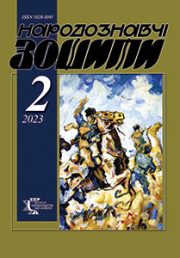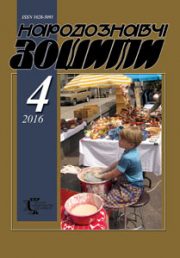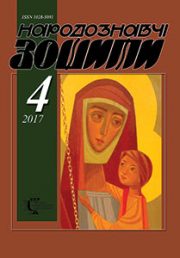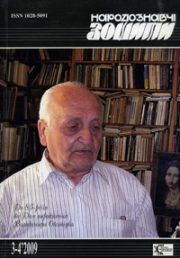The Ethnology Notebooks. 2023. № 3 (171), 525—541
UDK [392.51:391.983:582.091](477.85/.87+83:292. 452=161.2)
DOI https://doi.org/10.15407/nz2023.03.525
THE CEREMONIAL TREE IN THE TRADITIONAL WEDDING RITE OF UKRAINIANS OF THE CARPATHIANS
NAKONECHNA (HOSHCHITSKA) Tetiana
- ORCID ID: https://orcid.org/0000-0001-8596-8974
- Doctor of Philosophy, researcher fellow of department
- of Historical Ethnology of the Institute of Ethnology
- The National Academy of Sciences of Ukraine,
- 15, Svoboda Ave., 79000, Lviv, Ukraine,
- Contacts: e-mail: hoshchitska.tetiana@gmail.com
Abstract. Introduction: The traditional wedding ritual of Ukrainians in general, and of the Highlanders in particular, was one of the most important parts of family rituals, it was a complex of actions, resistant to transformations and saturated with various archaic features.
Problem Statement: An important attribute of a traditional wedding was a ceremonial wedding tree.
The object of the study is the wedding ritual of the Ukrainian Carpathians, and the subject is the traditional wedding tree, as its important attribute.
The scientific novelty lies in the fact that for the first time an attempt has been made to comprehensively outline the picture of the existence of the ceremonial wedding tree in the area of the Ukrainian Carpathians, to trace its local differences and to investigate the semantics of the recorded phenomena.
The main methods used by the author are structural, typological analysis, historical reconstruction and comparative methods. Results: Having outlined the picture of her daily life, we see that the wedding tree was primarily a kind of symbolic embodiment of the individual in the ritual. Also, through all the wedding ritual, there is an attempt by the autochthons to attract the productive power of the trees and to transfer certain of their properties to the main actors of the ritual. However, the most interesting thing for us is the fact that it is precisely in this part of the ritual culture that the ideas about the tree as a «road» between the worlds, a universal mediator that connects the world of the living and the dead, were most vividly reflected.
In general, the process of making, functioning, and destroying the ceremonial tree and its alloforms in the wedding rites of the Ukrainian highlanders shows all the signs of the process of inviting and «deporting» the spirits of deceased ancestors back to the afterlife.
Keywords: ritual tree, wedding rituals, family rituals, Ukrainian Carpathians, Bojky, Lemky, Hutsuls.
Received 24.04.2023
REFERENCES
- Hacket, B. (1997). New natural and political journeys in 1788—1795 through the Dacian and Sarmatian or northern Carpathians. Part III. Nuremberg, 1794 [fragments]. In: Balthazar Hacket and Ukraine: articles and materials (Pр. 30—36) [in Ukrainian].
- Hnatyuk, V. (1908). Boykiv wedding in Mshanets. Materiialy do ukrains’ko-ruskoi etnol’ohii (Vol. Х, pp. 1—29) [in Ukrainian].
- Kuzela, Z. (1908). Boykiv wedding in Lavochne. Materiialy do ukrains’ko-ruskoi etnol’ohii (Vol. Х, pp. 121—150) [in Ukrainian].
- Schnaider, J. (1906). People of Pechenizhyn. Lud (Vol. XII, pp. 277—309) [in Polish].
- Vovk, F. (1995). Marriage ritual and rites in Ukraine. In: Vovk F. Studies in Ukrainian ethnography and anthropology. (Pp. 219—323) [in Ukrainian].
- Zdоrovega, N.I. (1974). Essays on folk wedding rituals in Ukraine. Kyiv: Naukova dumka [in Ukrainian].
- Nesen, I. (2003). A tree in the wedding ritual of Kyiv Polissia. Kyivska starovyna, 6, 107—114 [in Ukrainian].
- Nesen, I. (2007). The wedding ritual of Central Polissia: traditional structure and relict forms (mid-19th—20th centuries). Kyiv [in Ukrainian].
- Pankiv, M. (2000). A wedding in the village of Verbivtsy in Horodenkiv region. Ivano-Frankivsk [in Ukrainian].
- Zelenin, D.K. (1991). East Slavic ethnography. Моscow: Nauka [in Russian].
- Gura, A.W. (1995). Wedding tree. In: Slavic antiquities: Ethno linguistic dictionary (Vol. 2, рр. 83—84). Moscow: Mezhdunarodnyye otnosheniya [in Russian].
- (1988). Мarriage among the peoples of Central and South-Eastern Europe. Moscow: Nauka [in Russian].
- Malkovich, I. (2014). 100 tales. The best Ukrainian folk tales with illustrations by prominent Ukrainian artists (Vol. 2) [in Ukrainian].
- (2020). Ethnographic image of modern Ukraine. Corpus of expeditionary ethnographic and folklore materials (Vol. 6: Folk housing culture. Ecology and organization of habitat). Kyiv: IMFE [in Ukrainian].
- (1989). Marriage among the peoples of Western and Southern Europe. Moscow: Nauka [in Russian].
- Nemets, V. (2016). The tree is one of the main subject-symbolic components of the wedding ceremony of the Bukovyna part of Hutsul Oblast (based on field materials from Putyl Oblast). Monuments of Tustan in the context of the development of the Carpathians in the prehistoric times and in the Middle Ages; problems of their preservation and use (Proceedings of the 3rd International Scientific Conference) (Pp. 106—109). Lviv [in Ukrainian].
- Shukhevych, V. (1999). Hutsul’schyna (Vol. 3). Verkhovyna [in Ukrainian].
- Hlavatska, L. (2011). Wedding rites of Eastern Boykivshchyna in the 30s and 60s of the 20th century. In: Sources for Ukrainian ethnology: materials of field research (Pp. 119—137) [in Ukrainian].
- Bereza, Y.M. (1934). «Korovaiu-korovaiu…». Zhyttia i Znannia, 7/2, 42—43 [in Ukrainian].
- Nemets, V. (2008). Field materials before topic of «Wedding ceremony» from the expedition to the Bohorodchans’kyj district, Ivano-Frankivs’koi area, 11—17.07.2008). In Archive of the HF LNU. F. Od. save 299-E. Arc. 1—118 [in Ukrainian].
- Kolberg, O. (1973). Gуry i Podgуrze (Part 1). In Works all (Vol. 54). Wroclaw; Poznan: Ludowa spoldzielnia wydawnicza [in Polish].
- Toronsky, O. (2007). Wedding songs 1878 р. (Pp. 15—75) [in Ukrainian].
- Bodak, Ya. (2007). Wedding in Lemkivshchyna. In: Lemkу wedding in the records of the 19th and early 20th centuries (Pp. 7—43) [in Ukrainian].
- Huzij, R., Varkhol, J., Varkhol, N. & Ostapyk О. (2002). Vesil’ni obriady. In Lemkivschyna (Vol. 2, pp. 94—109). Lviv: In-tut narodoznavstva NANU [in Ukrainian].
- Antoniv, P. (2014). Narodne vesillia v Oslavytsi na Lemkivschyni. The Ethnology notebooks, 1, 98—102 [in Ukrainian].
- Markevych, N.A. (1991). Customs, beliefs, cuisine and drinks of Little Russians. In: Ukrainians: folk beliefs, beliefs, demonology (Pр. 52—169) [in Russian].
- Syavavko, E. (1987). Folk customs and ceremonies. Family rituals. In: Hutsul region: historical and ethnological study (Pp. 302—318) [in Ukrainian].
- Goroshchko, L. (2005). Field materials before topic of «Сalendar and family custom and ceremonies» from the expedition to the Skolivs’kyj, Turkivs’kyj district, L’vivs’koi area, Verkhovyns’kyj district Ivano-Frankivs’koi area, Vyzhnyts’kyj, Putyl’s’kyj district, Chernivets’koi area, Rakhivs’kyj, Velykobereznians’kyj district, Zakarpats’koi area). In Archive of the IN NANU. F. 1. Оp. 2. Od. save 533. Arc. 1—183 [in Ukrainian].
- (2016). Ethnographic image of modern Ukraine. Corpus of expeditionary ethnographic and folklore materials (Vol. 4: Wedding ceremony). Kyiv: IMFE [in Ukrainian].
- Uzeneva, E.S. (2008). Ethnolinguistic materials from South-Western Ukraine (Usteryky village, Verkhovinsky district, Ivano-Frankivsk region). In: Carpatho-Balkan dialectal landscape. Language and culture; In memory of H.P. Klepykova (Pp. 323—347) [in Russian].
- (1907). Russian wedding. After the customs and customs of the people on Prut and Podil. Collected with illustrations by Stefania Pavlysevych and Ivan Nedostoyn, reported by M. Belous Kolomyya [in Russian].
- Vytvytskyi, S. (1993). Historical essay about the Hutsuls. Kolomyia: Kolomyia Museum of Folk Art of the Hutsul Region and Pokuttia named after Yosaphat Kobrynskyi [in Ukrainian].
- Kyrchiv, R. (1961). Polish ethnographic expedition of the Museum of Ethnography and Art Craft, Academy of Sciences of the Ukrainian SSR, July 1981. Diary of R.F. Kirchiv. In Archive of the IN NANU. F. 1. Оp. 2. Od. save 262. Arc. 1—135 [in Ukrainian].
- Lenno, T. (2015). Traditional wedding ceremonies of the Boyki of Transcarpathia: mid —20th century — beginning of 21st century (Kandidat dissertation). Institute of Folklore, Ethnography and Art History named after M.T. Rylskyi) [in Ukrainian].
- Kolberg, O. (1973). Rus Karpatska (Part 1). In Works all (Vol. 54). Wroclaw; Poznan: Ludowa spoldzielnia wydawnicza [in Polish].
- Holovatskyi, Ya. (1878). Folk songs of Galicia and Hungarian Rus (Part III: Ceremonial songs). Moscow [in Ukrainian].
- Bugera, I. (1997). Wedding in Lemkivshchyna. Ivano-Frankivsk [in Ukrainian].
- Illustrative fund of the library of the Institute of Ethnology of the National Academy of Sciences of Ukraine, «Vesillya», inventory number № 14494 [in Ukrainian].
- Pavlyuk, I. (1961). Wedding at Pokutta, 1961, I.S. Pavlyuk. In Archive of the IN NANU. F. 1. Оp. 2. Od. save 97. Arc. 1—36 [in Ukrainian].
- Pol, W. (1966). Works from the ethnography of the northern slopes of the Carpathians. Wroclaw [in Polish].
- Svitluk, P.M. (2008). Heavenly Well: Transcarpathian folk traditions, legends, beliefs, customs, traditions and life. Uzhhorod: Grazda [in Ukrainian].
- (1921). Fre Carpathian Ruthenia: to her liberators. Praha [in Czech].
- Zhelem, M. (2008). Matsyna Velyka — is a Lemkiv village. Historical and local history essay. Drohobych [in Ukrainian].
- Schnaider, J. (1906). People of Pechenizhyn. Lud (Vol. XIIІ, pp. 21—33) [in Polish].
- Starosolska, U. (1998). Hutsulshchyna: Pearl of the Ukrainian Carpathians. Philadelphia: Ukrainian Hutsul Society «Cheremosh» [in Ukrainian].
- Halajchuk, V. (2006). Mythological representations about plants. In Ethnogenesis and ethnic history of the Ukrainian Carpathians (Vol. 2, pp. 590—608). Lviv: Instytut narodoznavstva NAN Ukrainy [in Ukrainian].
- Mushinka, M. (2008). Family and household rituals of the village of Kurov, Bardeevsky district (Maternity, baptismal and wedding customs and ceremonies). In: Mushinka M. From the Father’s Threshold. Create your choice. Autobiography. Pratsі about the village of Kurіv and yogo outskirts (Vol. 1, рр. 499—586) [in Russian].
- Voropaj, O. (1993). The customs of our people. Ethnographic essay. Кyiv: Oberehy [in Ukrainian].
- Markovych, Mykhailo. «Open, mother, lisku, the son leads the daughter-in-law»: how they walked the wedding in the Carpathians. Retrieved from: https://localhistory.org.ua/texts/statti/vidkrivai-mamko-lisku-vede-sin-nevistku-iak-guliali-vesillia-y karpatakh/?fbclid=IwAR1ntbHUsq_JLdO_nZJbrmhax8GQTUNv7j-PTyGyFYZww87FOl4q1z1a_Ls (Last accessed: 11.03.2023) [in Ukrainian].
- Scientific publications and publishing activities of the National Academy of Sciences of Ukraine. Retrieved from: http://www.nas.gov.ua/publications Illustrative fund of the library of the Institute of Ethnology of the National Academy of Sciences of Ukraine, «Vesillya», inventory number № 14491 [in Ukrainian].
- Agapkina, T.A. (1994). South Slavic beliefs and rituals associated with fruit trees, in the general Slavic perspective. In Slavic and Balkan folklore (Ethnolinguistic study of Polissya) (Pp. 84—110). Моscow: Indrik [in Russian].
- Fischer, A. (1928). Rusini: outline of ethnography of Rus. Lviv; Warsawa; Krakow [in Polish].
- Konopka, V. (2019). Wedding rite in Pokutta (ethnographic materials from the village of Dolishne Zaluchcha Snyatinskyi and the village Potochyshche Gorodenkivskyi, Ivano-Frankivsk region). The Ethnology notebooks, 5, 1342—1357 [in Ukrainian].
- Karavaeva, L., Laboyko, M., & Tymets, N. (Eds.). (2021). Galicia of the 20th century in photos by Yulian Dorosh. Lviv: Apriori [in Ukrainian].
- Bolibrukh, L.V. Kalach is one of the types of traditional wedding cookies (based on the materials of the southwestern historical and ethnographic region of Ukraine). Retrieved from: http://конференция.com.ua/files/image/konf%2011/doklad_ 11_9_10.pdf (Last accessed: 11.03.2023) [in Ukrainian].
- (2004—2005). Ukraine and Ukrainians: types, landscapes, everyday life. Book of postcards: 30 gift postcards-pictures of the end of the 19th and the first half of the 20th centuries. Kyiv: Ivan Honchar Museum; Oranta [in Ukrainian].
- Oplestinova, H. (2016). The disappeared world of the Carpathian Rusive photo of Rudolf Hulka’s charts (1887—1961). Praha [in Czech].
- Goberman, D.N. (1972). Paintings of Hutsul potters. Leningrad: Art [in Russian].
- Goberman, D.G. (1980). Hutsul art. Moscow: Soviet artist [in Russian].
- Kajndl’, R.F. (2000). Hutsuls: their lives, customs and folk traditions. Chernivtsi: Мolodyj bukovynets’ [in Ukrainian].
- Levkievskaya, E.E. (2002). Slavic amulet. Semantics and structure. Моscow: Indrik [in Russian].
- Ostapyk, O. (1982). Field materials from the expedition to the Hutsul region in 1982 were collected by O. Ostapyk. In Archive of the IN NANU. F. 1. Оp. 2. Od. save 409. Arc. 1—64 [in Ukrainian].







